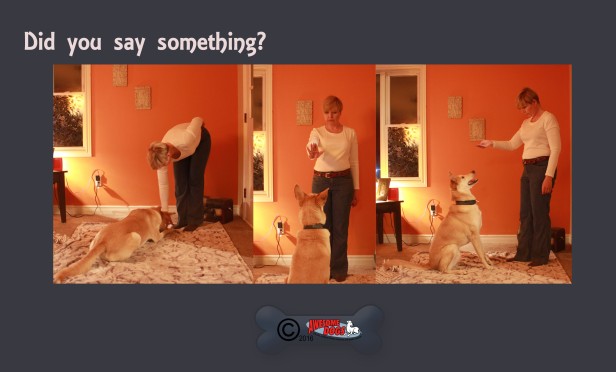Barks Blog
Why Your Dog Doesn’t Know Sit
By Yvette Van Veen
When I was a young girl, my grandmother would send gifts of books from Czechoslovakia. The books were filled with stunning moving pop-up illustrations. I learned a lot from those books. I learned how those illustrations popped up. I learned how one moving part operated another moving part. What I failed to learn was how to read Czech. My attention was so fixated on the illustrations that I memorized the words. I recited the story based on the illustration. I never focused on the letters. Illustrations overshadowed the letters.
Overshadowing is a well-researched part of dog training. One place it applies involves adding cues (or “commands” for those who still use that term) Animals, when simultaneously given two or more cues are likely going to learn about the most salient – to the detriment of the others. Which facet carries the most weight depends on many factors.
Lured downs offer an example many can envision. Dogs see humans bending at the waist during the lure. If owners simultaneously say, “down” while luring or pointing, the word is unlikely to register. Despite dozens or hundreds of repetitions, the dog stays focused on the owner’s gestures. The word, “down,” becomes irrelevant background noise. It predicts nothing of importance because with each repetition, the movement gives the dog all the information it needs. Touching the ground comes to mean “lie down” rather than the word. Pointing is perfectly acceptable if one wants to touch their toes in order to ask the dog to lie down. I just don’t know many people who put it on their wish list.
Overshadowing affects many areas of training. This is not a luring problem. It can affect targeting, shaping and capturing. It is not a positive reinforcement based problem. Overshadowing has far reaching tendrils that reach pretty much everywhere.
Gestures do not need to be grandiose. It can be as subtle as the wiggle of a finger or a raised eyebrow. We all have dog training tells much like poker players have tells. It takes self-awareness to compensate. Often it takes a second set of eyes to spot them.

This does not mean hand signals are bad. Rather that few people want ridiculous signals. No one wants to touch their toes to get a down. It’s annoying. Holding an arm extended for “stay” isn’t useful. You can’t hold your hand up to sign stay and tie your shoe at the same time. If you train with a prolonged gesture, that’s what the dog will need in order to understand.
Good hand signals are functional. It takes effort to teach a great verbal cue. Teach both but don’t mash them together and expect the dog to recognize them individually. Don’t blame a dog for misunderstanding cues that were never made clear.
This might seem persnickety. Who cares if signals are mashed so long as the method is “positive?” Frankly, it is a problem when many trainers tell clients to mash signals and then encourage “balance” to clean things up. Many repetitions become justification that the dog ought to know better and do better without recognizing that the repetitions were flawed.
Clients may feel that positive reinforcement failed because the dog is not responding to verbal cues. This perceived failure again leads to “discipline.” Positive reinforcement didn’t fail. It worked exactly how science said it would. In the absence of another reasonable explanation “dominant, stubborn, willful” can sound reasonable to a frustrated owner.
That’s a real shame because overshadowing is pretty easy to deal with. Cues need to precede the behaviour without interference. Fade lures. Remove training aides during shaping or targeting. Get a clean behaviour. Then purposely add in the cue, and only the cue. Spend a little time highlighting that these words or signs that are important and have meaning. Do this in a thoughtful and planned way.
If we dismiss science, then we don’t learn about factors such as overshadowing. I suppose it must be easier to justify corrections and sleep at night if one remains willfully oblivious to such things. It is a choice to ridicule science and then justify corrections under the pretense of “balance.”
Learning the science is hard. It demands that we regularly rip off the bandage that protects our fragile egos. We need to find the thing we have yet to learn. It goes beyond lip service. We can’t just say, “We all have more to learn.” You have to do something about it.
Learn better. Do better. Get better results. Often those who suggest this path went down it before. At least I certainly have. There are walls you hit where it seems like something isn’t working right. Finding out why is worthwhile.
Individually we should all lose a little sleep wondering if there isn’t some variation of overshadowing playing havoc with our cues (probably). We should wonder if it impacts other areas of training (it does). We should wonder if there are other effects to learn about (there are.)
Owners absolutely don’t need to learn decades of research in order to train their dog. The trainers they hire should.
The takeaway for owners is twofold. First, don’t mash your cues. Second, science often does have all the answers….and it makes training a lot less frustrating when you work with it rather than against it.
About the Author
Yvette Van Veen PCT-A is dog behavior consultant and owner of Awesome Dogs, in Dorchester, Ontario, Canada. She is also a long-time columnist and multiple Dog Writers Association of America award nominee, and currently writes a regular column for The Toronto Star. She has worked with rescue dogs for more than 14 years, focusing mainly on rural, roaming and feral rescue dogs from communities throughout Ontario and Quebec, Canada. She is also the creator of Awesome Dogs Shareables, an educational meme site providing resources and training tips in small, shareable formats.
